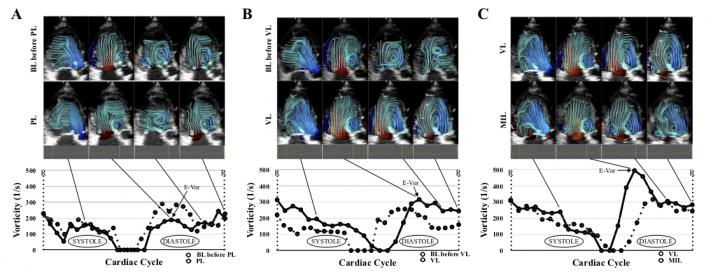
Credit: FIGURE ADAPTED FROM Am J Physiol Heart Circ Physiol 316: H882-H888, 2019. Copyright © 2019 the American Physiological Society
Japanese scientists at Tokyo University of Agriculture and Technology (TUAT), Teikyo University of Science, and Juntendo University have found — in animal studies — a close relationship between vortex flow and pressure differences in the ventricles, or lower chambers, of the heart. The new information could inform the development of new markers for cardiovascular dysfunction that can lead to heart failure.
Their findings were published on April, 2019 in the American Journal of Physiology-Heart and Circulatory Physiology.
Every beat of the heart consists of two stages. In the first stage, known as diastole, the left and right lower chambers of the heart (called ventricles) relax and expand, and blood flows into them from the left and right upper chambers (called atrium). Once the ventricles are full of blood, the second stage, known as systole, is triggered. The muscles in the ventricle walls contract and blood is pumped from the left ventricle to the aorta (main artery carrying oxygenated blood to the body), and from the right ventricle to the pulmonary artery (carrying deoxygenated blood back to the lungs).
Diastolic dysfunction is a common heart condition in both domestic animals and humans, particularly among the elderly, where the diastole stage does not function as efficiently as it should. The muscles in the ventricle walls become thickened and stiff, losing their elasticity, and do not relax and expand properly. As a result, the capacity of these chambers to fill up with blood is reduced. This in turn causes blood to accumulate in other areas of the body.
The restriction in flow causes pressure inside the ventricles to build up as blood pumped with the next heartbeat tries to enter the chamber which, due to its inability to expand properly, lacks sufficient capacity to accommodate it all. Diastolic dysfunction is characterized by an increased pressure in the left ventricle as the oxygenated blood returning from the lungs tries to enter. As the surplus blood has to go somewhere, it also causes blood and pressure to build up in the blood vessels around the lungs (pulmonary congestion) or in the vessels returning blood back to the heart (systemic congestion).
In the case of pulmonary congestion, fluid can leak through the vessel membranes into the alveoli (tiny air sacs that allows air exchange) in the lungs, resulting in pulmonary edema — a condition where oxygenation of the blood is impaired, leading to breathing difficulties and, in severe cases, to potentially fatal diastolic heart failure.
As blood flows from the left atrium into the left ventricle, it forms a swirling mass of fluid known as a vortex ring. In terms of its fluid dynamics, a rotating vortex is believed to flow more efficiently than a straight, steady flow of fluid and therefore assists filling of the left ventricle during diastole. A healthy heart that exerts sufficient suction force typically has a large intraventricular pressure difference, whereas a heart with diastolic dysfunction has a low intraventricular pressure difference.
Previous studies have suggested that diastolic vorticity, or fluid dynamics of the blood in the ventricle, can be used as an indicator of diastolic function. However, the link between intraventricular pressure difference and diastolic vorticity is unclear. It is thought that pressure differences within the ventricles is linked to the formation of vortexes, and that vortex flow could be used as a measure of ventricular relaxation that is associated with heart failure.
For this study, the researchers monitored six healthy anesthetized dogs to determine whether intraventricular fluid dynamics can be assessed clinically using non-invasive imaging techniques, and whether impaired fluid dynamics may be a source of diastolic dysfunction that can lead to heart failure.
“We showed the close relationship of vortex and intraventricular pressure difference and showed that both of them can become new markers of the left ventricular relaxation property,” said Ryou Tanaka, Associate Professor in the Department of Veterinary Surgery, Faculty of Veterinary Medicine, TUAT, and co-author of the paper.
Now that the researchers have assessed the relationship between intraventricular pressure differences and vortex flow in healthy canines, their next step is to evaluate intraventricular fluid dynamics in feline cases. According to the authors, these findings suggest that further studies using these indicators on diseased subjects is warranted.
###
About Tokyo University of Agriculture and Technology (TUAT)
TUAT is a distinguished university in Japan dedicated to science and technology. TUAT focuses on agriculture and engineering that form the foundation of industry, and promotes education and research fields that incorporate them. Boasting a history of over 140 years since our founding in 1874, TUAT continues to boldly take on new challenges and steadily promote fields. With high ethics, TUAT fulfills social responsibility in the capacity of transmitting science and technology information towards the construction of a sustainable society where both human beings and nature can thrive in a symbiotic relationship. For more information, please visit http://www.
Original publication:
Left ventricular vortex and intraventricular pressure difference in dogs under various loading conditions.
Matsuura K, Shiraishi K, Sato K, Shimada K, Goya S, Uemura A, Ifuku M, Iso T, Takahashi K, Tanaka R.
Am J Physiol Heart Circ Physiol. 2019 Apr 1;316(4):H882-H888
doi: 10.1152/ajpheart.00686.2018
Contact:
Ryou Tanaka, DVM, PhD
Associate Professor,
Department of Veterinary Surgery, Animal Medical Center
Tokyo University of Agriculture and Technology.
Email: [email protected]
Media Contact
Yutaka Nibu, PhD
[email protected]
Related Journal Article
http://dx.




